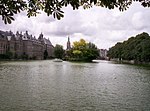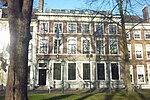Museum Bredius
Art museums and galleries in the NetherlandsBiographical museums in the NetherlandsFormer private collectionsHistoric house museums in the NetherlandsMuseums in The Hague

Museum Bredius is a museum named after Abraham Bredius on the Lange Vijverberg in The Hague. It is remarkable for its collection of etchings and paintings, but is most attractive to visitors for its accurate restoration of the 18th-century Herenhuis interior with period furnishings.
Excerpt from the Wikipedia article Museum Bredius (License: CC BY-SA 3.0, Authors, Images).Museum Bredius
Lange Vijverberg, The Hague Centrum
Geographical coordinates (GPS) Address Nearby Places Show on map
Geographical coordinates (GPS)
| Latitude | Longitude |
|---|---|
| N 52.081252777778 ° | E 4.3126555555556 ° |
Address
Kunsthandel Hoogsteder & Hoogsteder
Lange Vijverberg 15
2513 AC The Hague, Centrum
South Holland, Netherlands
Open on Google Maps










